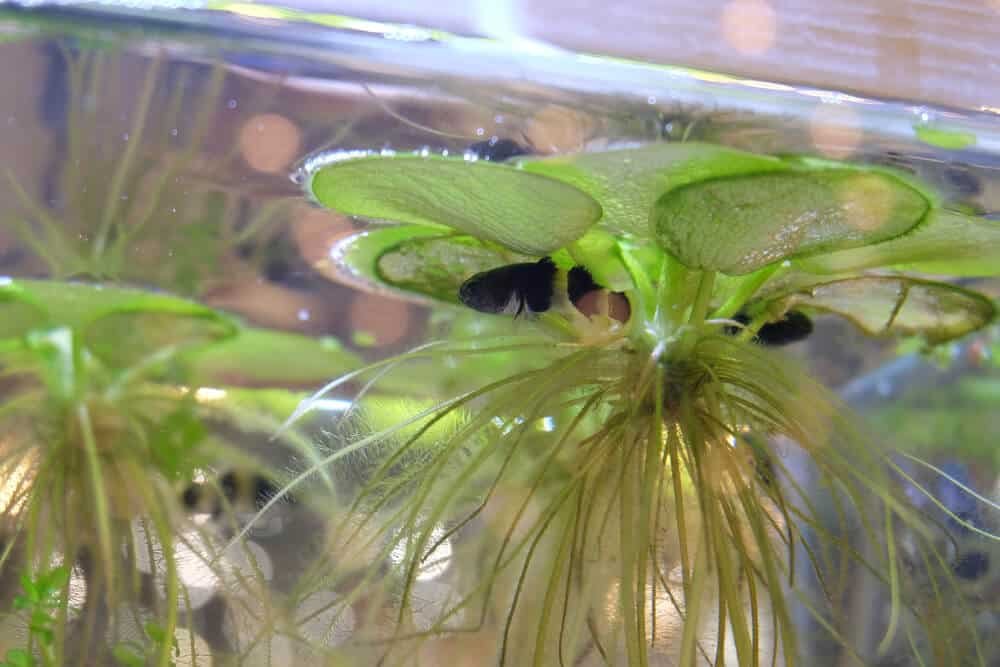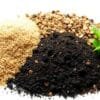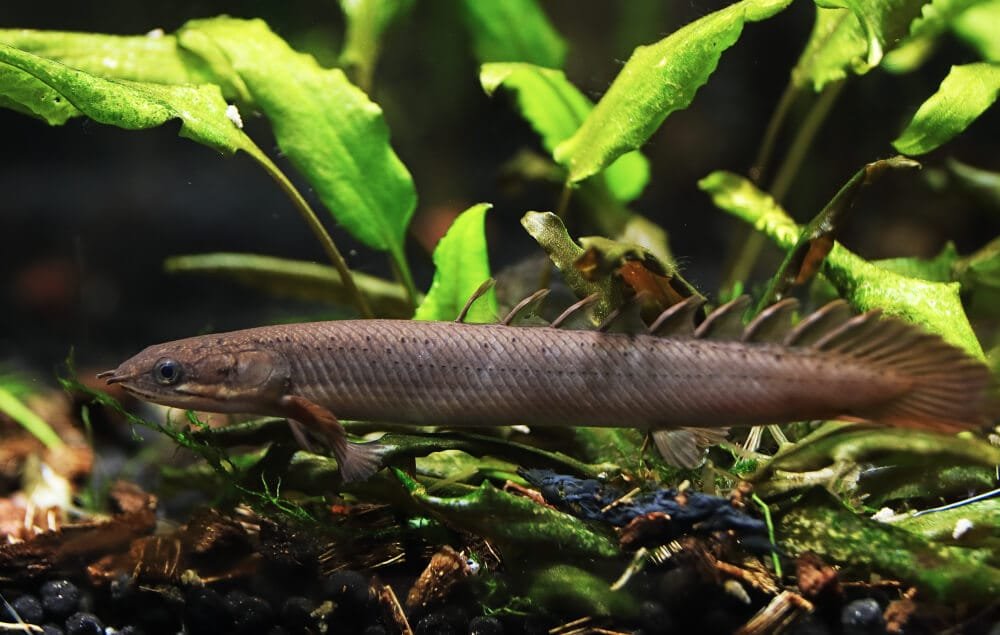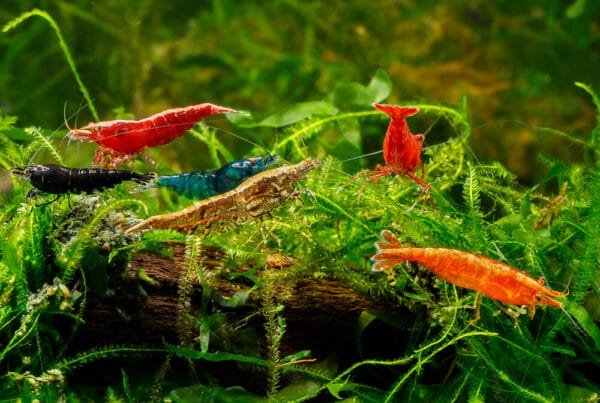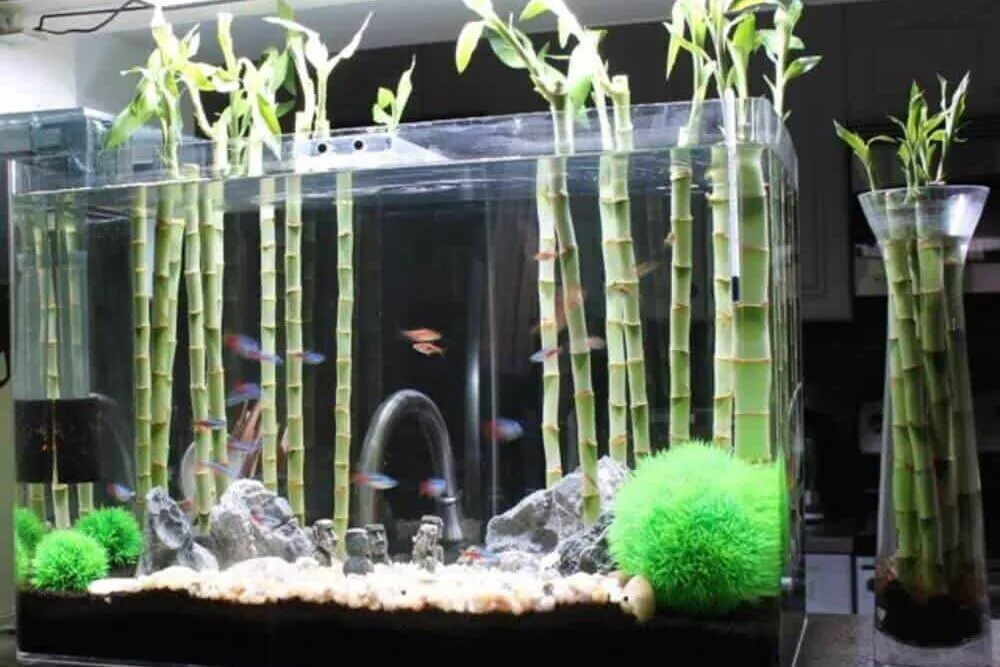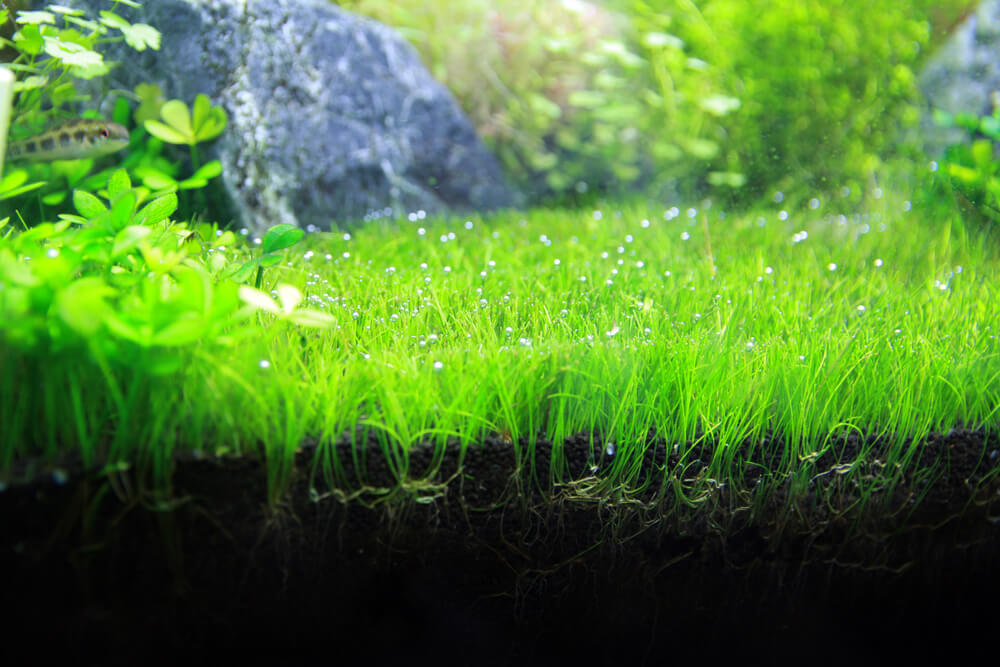Floating plants for aquarium do not only elevate your fish tank’s aesthetic appeal. These aquatic plants can also provide your aquarium and its inhabitants with many benefits, including more stable water conditions, an instant snack, and more hassle-free tank maintenance.
There are many species of floating aquatic plants. Each has characteristics that can be either beneficial or detrimental to fish life.
Knowing which floating plants to put in your aquarium can help you optimize your fish-keeping hobby, generating more joy as you watch your fish and plants exist in harmony.
Here are the things you must know about floating plants for fish tanks.
An Overview Of Floating Aquatic Plants For Aquariums
As the name implies, floating plants for aquarium are plant species with roots not anchored to the soil or any substrate. They are free-floating, moving with the water flow and providing shade for the fish and other aquarium inhabitants below.
Like ordinary plants, floating plants require carbon dioxide, water, and sunlight to thrive while producing energy and oxygen. They derive nutrition directly from the water, drawing organic substances, such as nitrates, phosphates, and potassium.
This natural plant function frees the water of unwanted chemicals, making the water parameters closer to the ideal than without plants.
10 Floating Plants You Can Put In Your Aquarium
Choosing a floating plant to add to an aquarium can be challenging for novice aquatics hobbyists. However, these ten floating plants should help you narrow your selection.
1. Duckweed

If you have goldfish in your aquarium, Duckweed is your go-to floating plant because goldfish love to chow on these plants. These fast-growing, miniaturized lotuses efficiently remove nitrates, potassium, phosphates, and other organic substances from the water.
Its nano-size also makes it a favorite of Betta, allowing them to hide under the tiny bright-green leaves and amongst the diminutive hanging roots.
2. Amazon Frogbit

A popular choice among pond owners, the Amazon frogbit is an excellent floating plant for large-sized fish tanks.
You only need several Amazon frogbits to cover your aquarium because they are large and can grow fast, giving shade to your livestock and minimizing pruning requirements.
Its hanging roots are perfect for laying eggs, growing fry, and developing juvenile fish.
3. Java Moss

Java moss is ideal for an aquarium with tiny shrimp and small fish communities and is one of the best floating plant species for beginner aquarists.
It has low maintenance requirements and is sufficiently versatile for various tank placements. You can have these plants floating on the surface, attached to driftwood, laid out like a green carpet, or set on aquarium walls.
4. Anacharis

This floating plant is perfect for beginner aquarists, requiring minimal maintenance without special lighting or equipment. They are suitable for medium to large-sized tropical aquariums with cooler temperatures and can grow pretty fast.
The best part about Anacharis is they are excellent at sucking up nutrients in the water while providing a readily available food source for fish.
5. Red Root

Most floating aquatic plants are green, making the Red Root Floater a welcome change to a thriving aquarium ecosystem.
Easy to maintain, this floating plant species has green leaves under low light and turns a deep red with increased light intensity. The roots retain their red color regardless of lighting conditions, hence, the name.
6. Floating Fern

This floating plant is ideal for aquariums with lower water temperature requirements. It is a fast-growing plant specie, suitable for fish communities with large appetites and equally productive excretion.
They thrive best in low-flow water environments and do not require carbon dioxide introduction into the water.
7. Dwarf Water Lettuce

The velvety and soft leaves of the fast-growing dwarf water lettuce make it an inviting snack for small fish and shrimp.
A native of East Africa’s Lake Victoria, these aquatic plants produce dense roots that hang along the water column. It provides a haven for breeding fish for their eggs and fry and an excellent hideout for shrimp.
8. Crystalwort Riccia

One of the most beautiful floating plants for an aquarium is the crystalwort riccia. This versatile aquatic plant can form elegant mats on the water’s surface, creating a golf course-like scenery.
It has minimal care requirements and is suitable for fish tanks with shrimp and breeding fish, giving them adequate hiding spaces for egg hatching and fry development.
9. Subwassertang
The German equivalent for freshwater seaweed, Subwassertang, is a highly recommended aquatic plant for shrimp aquariums. It does not produce any roots, requiring minimal to zero maintenance.
Although not as popular as other floating plants, the Subwassertang remains an excellent choice for beginner aquarists.
10. Salvinia Cucullata

Like the Subwassertang, Salvinia cucullata is a relatively unknown yet uniquely beautiful floating plant. The half an inch-sized leaves curl upwards, forming a distinct bag shape and giving the plant its elegant bouquet-like appearance when formed as clusters.
These plants are perfect for fish communities, thriving on organic wastes from fish food and fish excreta.
Benefits Of Floating Aquatic Plants In Fish Tanks
You might already know what floating aquatic plants to put in your fish tank. However, do you know the advantages of adding these plants to your aquarium? Read on.
Maintain And Stabilize Water Chemistry
Floating plants for aquarium are similar to land-based plant life – they require water, light, and carbon dioxide to produce energy and create oxygen. The oxygen dissolves in the water, which fish breathe through their gills.
Because of their oxygen-producing capabilities, floating plants can complement your fish tank’s aerator or oxygen supply to ensure a healthier environment for your fish.
Free-floating aquatic plants also draw nitrates, phosphates, ammonia, and other organic molecules in the water. These compounds come from fish excreta, uneaten fish food, and other organic materials.
Organic wastes can upset your fish tank’s water chemistry if there are no floating plants to remove them.
The combination of adequate oxygenation and efficient nitrate removal makes floating plants ideal for maintaining and stabilizing the water chemistry.
You will have less frequent water changes, and your aquarium water will be more suitable for your fish.
Provide Shade And Cover For Other Aquarium Life Forms
Even on land, plant life provides cover for other living organisms. We take shelter from the sun’s scorching heat by going in the shade of a tree. You can think of a similar function for floating aquatic plants.
Most fish species prefer swimming in water with subdued lighting. Floating plants provide fish stock with shade if the aquarium lighting turns brighter than they need. It makes them happier and less stressed, allowing fish to thrive.
Floating aquatic plants have structures emanating from the top. Fish can lay their eggs in roots and other plant appendages, hiding them from hungry predators.
Baby shrimp and fish fry can also thrive in these structures, free from the prying eyes of aggressive tank mates.
However, it is crucial not to overcrowd the fish tank with floating plants to allow light to reach other aquatic plants at the aquarium’s bottom. Otherwise, these plants will die.
Supplement Fish Nutrition
It is not uncommon for some aquarists to forget to feed their fish on time, leaving these aquatic pets hungry for a few hours. It should not be a problem if they can nibble on some floating plants in the fish tank.
These life forms are as nutritious as their land-based counterparts, making them excellent snacks for your fish friends.
Microorganisms can also grow on roots and other submerged plant structures. These life forms are an excellent food source for fish fry and tiny shrimp.
Setting Up Your Fish Tank For Floating Aquatic Plants
It is easy to grow floating aquatic plants. However, they require a slightly different aquarium setup to promote optimum growth without undermining the other fish tank inhabitants.
Hoodless or Lidless
Floating aquatic plants have their tops above the water’s surface. Hooded aquariums can produce extreme humidity between the lid and the water, making them unsuitable for plant growth.
Hence, a lidless or hoodless fish tank is necessary to grow floating aquatic plants.
Unfortunately, leaving the aquarium top open can be risky for some fish species that jump out of the water. It would be best to put a screen on top if you wish to put highly active fish in the aquarium.
Lighting
Removing the aquarium hood robs you of putting artificial lighting for your ecosystem because many of these fixtures are built-in.
Your best recourse is clip-on lights, desk lamp-style lighting fixtures, or hanging pendant lights to illuminate the fish tank.
Filter
Floating plants remove organic substances from the water to improve and stabilize water chemistry. However, a filtration system remains crucial because these aquatic plants grow best in still, low-flow water.
The best filter for floating plants is a sponge filter because it creates almost negligible water flow.
Alternatively, you can secure a sponge to your power filter’s intake to dampen the water current. Placing driftwood or rocks over the power filter can also break up the water flow, making it gentler for floating plants.
How To Care For Your Aquarium Floating Plants
Although floating plants for aquarium are hassle-free to maintain, they still require the proper care to continue providing benefits to the fish tank and its inhabitants.
Nutrition
Floating plants draw nutrients from the aquarium water containing uneaten fish food and organic wastes from fish excreta.
You can add a liquid supplement to improve your water’s nutrient content if you will not stock the aquarium with fish species or if you want your floating plants to grow faster.
Carbon Dioxide
All plants require carbon dioxide to produce food, including floating aquatic plants. Exposed or non-submerged parts of floating plants can draw carbon dioxide from the surrounding air.
Unfortunately, some aquatic plants that grow beneath the water’s surface cannot obtain carbon dioxide. An example of such a plant is the Java moss.
It would be best to introduce CO2 into the aquarium for these plant species to thrive.
Propagation
Although some floating plants produce flowers, most species grow by division or daughter plants. You can separate these juvenile floating plants and allow them to float on the water.
Alternatively, you can leave them to self-detach and float by themselves.
Tank Maintenance
One of the advantages of putting floating plants in fish tanks is less frequent tank maintenance. Aquatic plants consume nitrates, phosphates, and other organic substances in the water to improve water conditions.
However, it is still advisable to perform periodic partial water changes while assessing and monitoring the water parameters with a test kit. It is also crucial to keep the aquarium substrate clean.
Checking Floating Plant Growth
Aquatic plants have a robust growth rate, covering your aquarium’s top surface within weeks. It would be best to remove some of the floating plants to allow natural light to permeate through the fish tank.
Alternatively, you can use floating rings to create a ‘window’ on the water’s surface, preventing floating plants from intruding into this area and shading the bottom-dwelling plants.
Suitable Tank Mates
Floating plants are stiff competitors to algae. They consume the organic matter that algae need to grow and multiply, leaving the fish tank almost algae-free.
Unfortunately, limiting algae growth in the aquarium might be harmful to some fish species, such as Otocinclus, Plecos, Siamese algae-eaters, Nerite snails, and Amano shrimp.
These aquarium inhabitants will not have algae to eat. Hence, it would be best to put only a small number of floating plants in your aquarium if you have these tank mates.
Otherwise, floating plants are excellent hiding places and snack sources for most fish species. For example, Bettas love lurking in the shade of these aquatic plants.
Things To Consider When Picking Floating Plants For Your Aquarium
You already know the floating plants best suited for your aquarium, including their benefits, tank setup, and care requirements. But what if you want to choose your floating aquatic plants yourself? Here are several considerations.
Life Forms Present In The Aquarium
You will want floating plants with extensive root systems if you have breeding fish. These fish species need hidden areas to secure their eggs while ensuring a haven for fry. Your breeding fish will feel safer with such floating plants.
On the other hand, fish with a voracious appetite should coexist with fast-growing floating plants. You can put duckweed, red root, floating fern, dwarf water lettuce, Salvinia cucullata, Subwassertang, or Amazon frogbit in your fish tank.
These floating plant species absorb more nitrates and other nitrogenous wastes in the water, safeguarding your fish.
However, it would be best to avoid fast-growing floating plants if you have algae feeders in your aquarium. Examples of fish that eat algae include Otocinclus, Cherry shrimp, Bristlenose Plecos, Amano shrimp, Nerite snails, twig catfish, and Chinese and Siamese algae eaters.
Subwassertang, crystalwort riccia, mosaic plant, and banana plant are more suitable for these fish.
Fish Tank Size
The cutoff aquarium size for floating plants is 40 gallons. Any fish tank smaller than 40 gallons should accommodate only smaller, slow to moderate-growing floating aquatic plant species.
Subwassertang and Java moss make excellent candidates.
Fish tanks at least 40 gallons in capacity can accommodate almost any floating plants, including fast-growing ones.
Aquarium Lighting
Most floating plants thrive in diverse lighting conditions. However, some species require low to moderate light to grow optimally.
For example, Subwassertang, crystalwort riccia, Amazon frogbit, Java moss, water sprite, Anacharis, and water wisteria cannot tolerate intensely bright light.
You will also not want floating plants to block the light to the aquarium’s bottom-dwelling plants. Fortunately, some species are easy to thin out, giving sufficient space for light to shine through. An example of such a plant is duckweed.
Floating Plants’ Growth Rate
Many floating aquatic plants have a moderate to fast growth rate, making upkeep somewhat challenging. You will need more frequent pruning and maintenance to keep these plants in check.
Slow-growing floating plants might be more suitable for aquarists who cannot commit to a strict pruning regimen.
Examples of these are mosaic plants and Subwassertang. Java moss, crystalwort riccia, and banana plant are also excellent choices because they have a moderate growth rate.
Aquarium Aesthetics You Want To Achieve
Some floating plants look like miniature water lilies or dwarf lotuses, while others resemble a flower bouquet. Other plant species create a green column extending downwards from the water’s surface.
It would be best to consider how you want your aquarium to look to determine the floating plant that best complements your fish tank’s aesthetics.
Frequently Asked Questions
Are Floating Plants Good For Aquarium?
Yes, floating plants are good for aquariums. These plant species mature and proliferate quickly, taking in phosphates, nitrates, and other nitrogenous wastes in the water.
They serve as a low-cost, maintenance-free, natural filtration system, saving your fish against the harmful effects of too much nitrates and phosphates in their environment.
Maintaining the ideal water chemistry is effortless with floating plants in the aquarium. So is cleaning. You can get away with less frequent water changes because there are not many phosphate and nitrogenous wastes to remove.
Aquatic plants are similar to land-based plant species. They require carbon dioxide for photosynthesis and give off oxygen as a byproduct of their metabolic processes.
Floating plants make excellent, hassle-free, cost-effective natural aerators that give your fish the life-giving oxygen they need.
Floating plants are not only beneficial to the fish tank’s water chemistry. They can also be excellent snacks for your fish.
For example, duckweed is an excellent floating plant for aquariums because it is a readily available food source for fish. You reduce the risk of underfeeding your fish while ensuring they receive nutrients fish pellets or flakes do not contain. Your fish gets a more balanced diet necessary for optimum health.
Do Floating Plants Oxygenate The Water?
Yes, floating plants oxygenate the water. These plant species also require water, sunlight, and carbon dioxide to produce starch by photosynthesis. In turn, photosynthesis creates oxygen as a byproduct.
However, it is essential not to overcrowd the aquarium with floating plants to facilitate photosynthesis in the submerged portions.
Do Floating Plants Filter Water?
Yes, floating plants can filter the water in an aquarium. These free-floating plant species do not have roots anchored in substrates or soil, drawing 100% of their nutrition directly from the fish tank water.
Aquarium water contains nitrates, ammonia, and other nitrogenous wastes from fish excrement. Fish pellets and flakes can also contain potassium, phosphorus, and phosphate that can mix with the water when dissolved.
Floating plants’ root systems also absorb these chemicals for growth, freeing the fish tank water of these harmful substances.
Since floating plants consume phosphate, nitrogenous substances, and other nutrient wastes in the water, fish keepers also get to control algae growth.
Do Floating Plants Reduce Evaporation In Aquarium?
Yes, floating plants can reduce evaporation in an aquarium. Placing duckweed to cover 40 to 60 percent of the fish tank’s water surface can create an oily film that serves to prevent excessive water loss through evaporation.
Will Floating Plants Help With Biofilm?
Floating plants might or might not help with biofilm. Scientists describe biofilm as a community of microorganisms, mainly bacteria, protected from the environment by a self-produced matrix made from polysaccharides.
Organic wastes in the aquarium water release lipids and carbohydrates that facilitate bacterial proliferation and uncontrolled biofilm formation.
Fish excreta, dissolved fish food, and diseased or decaying aquatic plants can produce organic wastes.
Floating plants that can absorb these organic wastes through the roots can help mitigate biofilm production.
Unfortunately, biofilm persists if the amount of organic matter in the water exceeds the floating plants’ absorption capabilities.
Conclusion
Floating plants for aquarium are excellent additions to a thriving aquatic ecosystem, providing fish with shade and hiding spots while ensuring a more stable water environment.
These aquatic plants remove nitrates and other toxins from the water while introducing life-giving oxygen for fish and other aquarium living organisms to breathe in.
Choosing the ideal floating aquatic plants for your fish tank depends on your fish stock, aquarium size, lighting, plant growth rate, and required aesthetics.
Only with the best floating plant species can you guarantee happy and stress-free fish and a healthy ecosystem.
